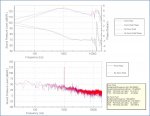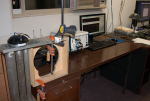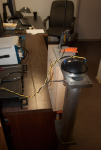I am about to finish the second of two cabinets loaded with Celestion CDX14-3050 high frequency (HF) drivers using three inch Titanium/Polyimide surround diaphragms.
http://www.diyaudio.com/forums/mult...ual-single-point-source-horn.html#post4114406
I received a production sample of the driver from Phil Graham (thanks again Phil!) but unfortunately it was 16 ohms, the factory politely refused to sell me another 16 ohm driver without purchasing the minimum order of 96 units, 95 more than I require.
The CDX14-3050 is available in single units in the 8 ohm version, so to get a matched pair I purchased one and another 8 ohm diaphragm.Upon removal of 16 ohm diaphragm, to my surprise the gap was partially filled with Ferrotec’s APG S17N Audio Ferrofluid, a mixture of a reddish-brown viscous fluid with a synthetic ester oil carrier liquid supporting ferrous metal particles. The specification sheet for the CDX14-3050 does not mention ferrofluid, no packet of ferrofluid accompanied the diaphragm, so unsure whether the oil is even currently used I replaced the diaphragm without cleaning the gap.
Over the course of four decades I have replaced dozens of HF compression driver diaphragms of all sorts, but this was only the second time I've encountered ferrofluid in the gap. Since I had no idea what type of oil used, much less having any on hand, had to put the new diaphragm in without cleaning the gap, about the equivalent of changing the oil in your car without changing the filter.
After installation of the new diaphragm (after putting the cabinet back on) and testing found the HF polarity was now reversed, and knowing the oil possesses damping and heat wicking properties, I asked these questions to Celestion's "Dr. Decibel ":
1) The CDX14-3050 specification sheet does not mention ferrofluid, does it use ferrofluid currently?
2) If the answer to question # 1 is yes, what is the proper ferrofluid type and volume in cc or ml for a standard "fill", and where can I obtain it?
3) How long does the ferrofluid used last before it's properties degrade?
4) Since the 8 ohm diaphragm shipped with no new ferrofluid, not knowing the answer to the above questions, I left the existing ferrofluid (which still looks brownish, not black) in the gap. Some fluid was retained on the old coil, so whatever volume originally used has been reduced by perhaps 5-10%.
How critical is the volume of ferrofluid used regarding frequency, phase, transient, distortion, and power response performance?
5) Since much of the driver's use will be in dusty environments that will eventually contaminate the ferrofluid and may require an "oil change" before it normally would "go bad", my preference would be to simply not use ferrofluid at all. What differences in frequency, phase, transient, distortion, and power response performance will the driver*exhibit without ferrofluid?
6) Does the diaphragm move forward (towards the horn) when positive (+) signal is applied to the red terminal?
7) Do both the 8 and 16 ohm diaphragms the same polarity convention?
8) Any suggestions on who might be willing to buy a used 16 ohm diaphragm or swap for an 8?
After a few weeks time, the answers received (after the first reply of "Sorry. Another awkward one….Can I just tell him not to worry about the ferrofluid? and second "don’t worry about the ferrofluid when you replace the diaphragm, it’s basically there to perform a secondary cooling function, but will not affect the operation in any meaningful way.") after pressing the "Doc" are as follows:
1) No answer, but implications both the 8 and 16 ohm still use ferrofluid.
2) A"fill" is .5ml of Ferrotec’s APG S17N .
3,4) We would anticipate the ferrofluid lasting as long as the compression driver. But of course it entirely depends on usage. If you find yourself replacing the diaphragm multiple times, it’s probably worth refreshing the Ferrofluid.
As the magnet assembly is a closed system, we wouldn’t anticipate it being contaminated in dusty environments.
5) Any test data for the compression driver without ferrofluid isn’t available to me. So either it hasn’t been done, or more likely it’s buried in a 10 year old notebook somewhere having never seen the light of day. So unfortunately I’m not going to be able to supply that information.
6) Yes.
7) Yes. (This means I probably put the diaphragm in backwards, resulting in the red wire going to the "-" terminal, doh.)
8) I don’t know of anyone who might like to buy a used diaphragm, but a lot of the Internet audio forums have trade and sale sections, so it might be worth taking a look at those…
As anyone with a rudimentary knowledge of compression drivers knows, the "magnet assembly" contains a gap with a voice coil in it, and the gap collects airborne particulates, requiring occasional cleaning when operated in dusty environments, and anybody who has ever changed engine oil knows that it can turn to sludge if not filtered and changed regularly.If anything, ferrofluid is more subject to problems than engine oil, reports of it having differing response as it ages, or even drying up to the point where the coil is stuck are easy to find.
I have personally heard system operators "warming up" drivers after a system was pulled from sub freezing trucks, the difference in sound between cold and warm ferrofluid was easily audible.
I certainly don't buy the good Dr.'s suggestion that Celestion engineers would import and use Ferrofluid if it didn't make much difference in response.
My inclination is to remove the ferrofluid so I don't have to deal with oil contamination and breakdown, but at the same time, the CDX14-3050 measures so smooth (other than one HF dip around 11 kHz) that I'd hate to mess with it, and cleaning out the ferrofluid is a time- consuming process.
So these questions remain:
1) How long does Ferrotec’s APG S17N used last before it's properties degrade?
2) How many hours of driving dust storms (like every other show..) before the Ferrofluid's properties change?
3) What measured differences will .5ml of APG S17N make in a 3" Titanium/Polyimide surround driver's phase, transient, distortion, and power response performance?
4) Anyone interested in buying a 16 ohm ohm CDX14-3050 diaphragm, or trading for an 8 ohm ?
Art
http://www.diyaudio.com/forums/mult...ual-single-point-source-horn.html#post4114406
I received a production sample of the driver from Phil Graham (thanks again Phil!) but unfortunately it was 16 ohms, the factory politely refused to sell me another 16 ohm driver without purchasing the minimum order of 96 units, 95 more than I require.
The CDX14-3050 is available in single units in the 8 ohm version, so to get a matched pair I purchased one and another 8 ohm diaphragm.Upon removal of 16 ohm diaphragm, to my surprise the gap was partially filled with Ferrotec’s APG S17N Audio Ferrofluid, a mixture of a reddish-brown viscous fluid with a synthetic ester oil carrier liquid supporting ferrous metal particles. The specification sheet for the CDX14-3050 does not mention ferrofluid, no packet of ferrofluid accompanied the diaphragm, so unsure whether the oil is even currently used I replaced the diaphragm without cleaning the gap.
Over the course of four decades I have replaced dozens of HF compression driver diaphragms of all sorts, but this was only the second time I've encountered ferrofluid in the gap. Since I had no idea what type of oil used, much less having any on hand, had to put the new diaphragm in without cleaning the gap, about the equivalent of changing the oil in your car without changing the filter.
After installation of the new diaphragm (after putting the cabinet back on) and testing found the HF polarity was now reversed, and knowing the oil possesses damping and heat wicking properties, I asked these questions to Celestion's "Dr. Decibel ":
1) The CDX14-3050 specification sheet does not mention ferrofluid, does it use ferrofluid currently?
2) If the answer to question # 1 is yes, what is the proper ferrofluid type and volume in cc or ml for a standard "fill", and where can I obtain it?
3) How long does the ferrofluid used last before it's properties degrade?
4) Since the 8 ohm diaphragm shipped with no new ferrofluid, not knowing the answer to the above questions, I left the existing ferrofluid (which still looks brownish, not black) in the gap. Some fluid was retained on the old coil, so whatever volume originally used has been reduced by perhaps 5-10%.
How critical is the volume of ferrofluid used regarding frequency, phase, transient, distortion, and power response performance?
5) Since much of the driver's use will be in dusty environments that will eventually contaminate the ferrofluid and may require an "oil change" before it normally would "go bad", my preference would be to simply not use ferrofluid at all. What differences in frequency, phase, transient, distortion, and power response performance will the driver*exhibit without ferrofluid?
6) Does the diaphragm move forward (towards the horn) when positive (+) signal is applied to the red terminal?
7) Do both the 8 and 16 ohm diaphragms the same polarity convention?
8) Any suggestions on who might be willing to buy a used 16 ohm diaphragm or swap for an 8?
After a few weeks time, the answers received (after the first reply of "Sorry. Another awkward one….Can I just tell him not to worry about the ferrofluid? and second "don’t worry about the ferrofluid when you replace the diaphragm, it’s basically there to perform a secondary cooling function, but will not affect the operation in any meaningful way.") after pressing the "Doc" are as follows:
1) No answer, but implications both the 8 and 16 ohm still use ferrofluid.
2) A"fill" is .5ml of Ferrotec’s APG S17N .
3,4) We would anticipate the ferrofluid lasting as long as the compression driver. But of course it entirely depends on usage. If you find yourself replacing the diaphragm multiple times, it’s probably worth refreshing the Ferrofluid.
As the magnet assembly is a closed system, we wouldn’t anticipate it being contaminated in dusty environments.
5) Any test data for the compression driver without ferrofluid isn’t available to me. So either it hasn’t been done, or more likely it’s buried in a 10 year old notebook somewhere having never seen the light of day. So unfortunately I’m not going to be able to supply that information.
6) Yes.
7) Yes. (This means I probably put the diaphragm in backwards, resulting in the red wire going to the "-" terminal, doh.)
8) I don’t know of anyone who might like to buy a used diaphragm, but a lot of the Internet audio forums have trade and sale sections, so it might be worth taking a look at those…
As anyone with a rudimentary knowledge of compression drivers knows, the "magnet assembly" contains a gap with a voice coil in it, and the gap collects airborne particulates, requiring occasional cleaning when operated in dusty environments, and anybody who has ever changed engine oil knows that it can turn to sludge if not filtered and changed regularly.If anything, ferrofluid is more subject to problems than engine oil, reports of it having differing response as it ages, or even drying up to the point where the coil is stuck are easy to find.
I have personally heard system operators "warming up" drivers after a system was pulled from sub freezing trucks, the difference in sound between cold and warm ferrofluid was easily audible.
I certainly don't buy the good Dr.'s suggestion that Celestion engineers would import and use Ferrofluid if it didn't make much difference in response.
My inclination is to remove the ferrofluid so I don't have to deal with oil contamination and breakdown, but at the same time, the CDX14-3050 measures so smooth (other than one HF dip around 11 kHz) that I'd hate to mess with it, and cleaning out the ferrofluid is a time- consuming process.
So these questions remain:
1) How long does Ferrotec’s APG S17N used last before it's properties degrade?
2) How many hours of driving dust storms (like every other show..) before the Ferrofluid's properties change?
3) What measured differences will .5ml of APG S17N make in a 3" Titanium/Polyimide surround driver's phase, transient, distortion, and power response performance?
4) Anyone interested in buying a 16 ohm ohm CDX14-3050 diaphragm, or trading for an 8 ohm ?
Art
Last edited:




